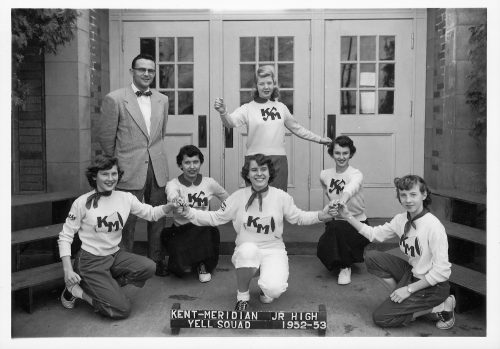Here’s another blast from the past — my mother was on the junior high “yell squad” when she was 13 or 14 years old (she’s the one on the far left). Once again, as I’m going through these old photos, I am struck by how godawful bad casual photography got to be in the 1970s. Kodak should be ashamed. I have so many photos from my youth that are smeared and grainy, with color blooming over the details, and then I see my mother’s youth, and it’s all these crisp fine black & white images that are fun to look at.
At least I can say that in my home photo collection I switched to taking B&W on my old Pentax in the 1980s, and also to color slide film (that’s a whole ‘nother tangle, converting 35mm color slides to digital images.)



It was the time when Kodak brought photography to more of the masses than every before. The 110 Instamatic pocket cameras were horrible. Plastic lenses, and that teeny tiny negative that if you had enlarged to more than 3X5 made you think you needed glasses.
I fired up the old slide projector, projected the slides onto a white wall and used a digital camera on a tripod to take pictures of the projected images. It worked surprisingly well.
Kodak gave us what we were willing to pay for, it’s not like any other company did better getting super inexpensive photography to the masses prior to digital.
My grandfather left me a few hundred color slides on Kodak Ektachrome. WOW, they are awesome. Super crisp and clean after 70 years. The nostalgic emotions they evoke are powerful.
I like the phrase “Yell Squad.”
About super inexpensive photography: it was already there, looked great, and was ultra sharp. B&W, 35mm.
But it wasn’t color.
Just completed an archiving of all my mum’s effects including copious b&w photos taken with a Kodak Brownie Cresta 3 in the 60’s – she passed away just over three years ago. I was struck by how large the negatives were in relation to the photos for 120 film and each roll could have as little as eight exposures.
It seems like Kodak was trying to find the bare minimum in quality that consumers would tolerate. If you remember the Disc cameras from the early 80s you can see the point where they went too far even for the average snapshot shooter. I had one in high school and at 10x8mm the negatives were a grainy mess even with small prints. The format deserved to fail and did.
Kodak should be ashamed about a lot of things, notably when they decided to throw away their US market dominance with both hands by turning dedicated loyal Kodak employees into independent contractors for less money and no benefits. Unsurprisingly, their better employees left for greener pastures (mostly at Fuji) and Kodak was left with a workforce of indifferent underperformers. You can thank upper management for that brain fart. Kodak then decided to screw over their loyal customers by discontinuing a lot of the better 35mm film format in favor of “smart film” or APS which was smaller (24mm vs standard 35mm format) and had the dubious advantage of printing the f-stop and shutter speed directly on the film. It was more expensive, required dedicated cameras and processing for a smaller image size. Kodak then decided to get rid of all the assets that still made money, ie., scientific film and chemicals. But upper management golden parachuted their way out of that dumpster fire and Kodak is now bankrupt and mostly makes whatever money they have in patent infringements.
Color reversal film is and was beautiful. Color negative film is usually a shitshow, whose print quality largely depends on the quality of processing and the skill of the print technician. Its sole redeeming quality is a wide latitude for exposure. With reversal, you either have the exposure or you largely have nothing. Reversal is meticulous, whereas negative can largely be used by anyone with opposable thumbs.
Sony used to make a really beautiful B&W instant reversal film but the emulsion would flake off the acetate base if you so much as looked at it sideways. Polachrome. The weird chemical smell was half the fun.
I miss Ilfochrome (aka Cibachrome). Ciba-Geigy-Sandoz (aka Novartis) stopped manufacturing in 2011. There was nothing like it. The giclee print process isn’t even close.
@3 Fuji gave us Velvia. Kodak was just lazy and greedy and and rested on their Kodachrome laurels for decades while Fuji ate up market share. Sony has always been a shitshow, due to upper management idiocy/psychosis. Everything Sony touches or acquires turns to crap. It’s the Sony way. (Exhibit A: the Spiderman franchise. The Spiderman-Marvel joint movies never happened because neither company could figure out how to share billions in ticket sales and merchandizing. Their executives still get paid millions to lose money and opportunities for their shareholders.)
I used to work in a photo shop and man, I hated having to process APS negatives.
I extensively used Kodak Pan-X when I was into B&W and it was a nice film that enlarged to 8X10 easily. I still have some of my original prints in my house. I also used Tech-Pan for astrophotography. Granted, we had to hypersensitize it by baking it in a chamber pressurized with a mix of hydrogen and nitrogen (forming gas). But it made the 25 ASA film as sensitive as 400 with no increase in grain size. Fantastic stuff…until CCDs became affordable and killed film astrophotography (unless you were using large format glass plates.